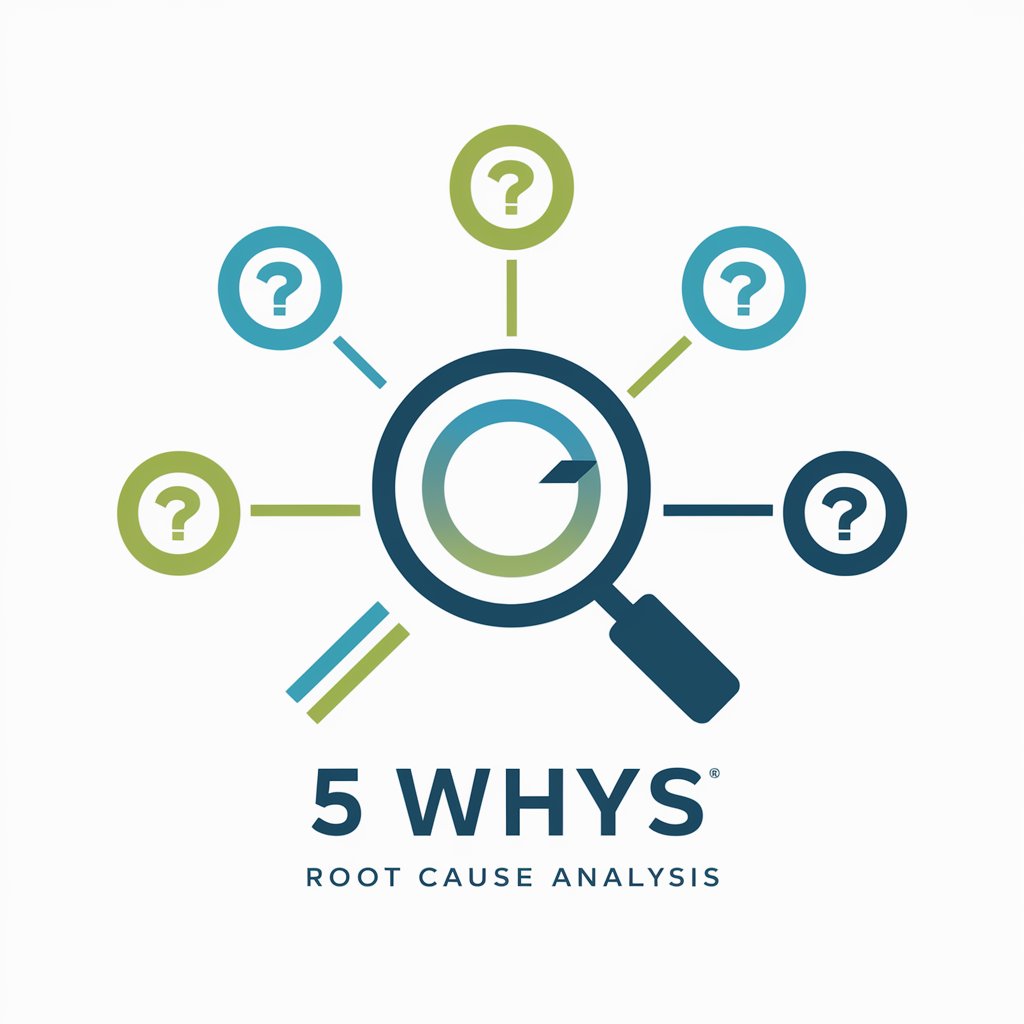
5 Whys - Root Cause Discovery

Uncover deeper truths with AI-driven analysis.
Start 5 Whys Analysis
Explain the 5 Whys Technique
See an Example
Need Help Formulating a Problem?
Get Embed Code
Introduction to 5 Whys
The 5 Whys technique is a problem-solving method developed by Sakichi Toyoda and widely used within the Toyota Motor Corporation during the manufacturing process. The technique involves asking the question 'Why?' five times in succession to drill down from the symptom of a problem to its root cause. This iterative questioning strategy helps identify the underlying issue that leads to a defect or problem, enabling the development of a sustainable solution. For example, if a machine stops working, the first 'Why?' might reveal that a component failed. Asking 'Why?' again might show that the component was incorrectly installed, and further questioning could uncover that the installation process is not adequately defined, pointing to the root cause: a lack of clear process documentation. Powered by ChatGPT-4o。

Main Functions of 5 Whys
Problem Identification
Example
Identifying the root cause of software bugs
Scenario
In software development, a bug is reported that causes the system to crash. The first 'Why?' reveals the system crashes when processing large files. Further questions uncover that the crash is due to insufficient memory allocation, which is traced back to the software not dynamically allocating memory based on file size, ultimately pointing to inadequate system requirements analysis.
Process Improvement
Example
Enhancing efficiency in a production line
Scenario
A production line consistently fails to meet its output targets. The initial 'Why?' indicates that machine downtime is too high. Subsequent questioning leads to the discovery that maintenance is reactive rather than proactive, with deeper analysis showing that maintenance schedules are not being followed because they are not aligned with production schedules, highlighting the need for integrated scheduling.
Root Cause Analysis
Example
Addressing customer complaints in a service industry
Scenario
A hotel experiences a spike in customer complaints about room cleanliness. The first 'Why?' points to rooms not being cleaned on time. Further investigation shows that cleaning staff are overloaded with rooms, which is traced back to a recent policy of minimizing downtime between check-out and check-in without adjusting staffing levels or cleaning protocols.
Ideal Users of 5 Whys Services
Business Managers and Leaders
These individuals can utilize the 5 Whys technique for operational troubleshooting, process improvement, and strategic planning. It helps them identify inefficiencies and areas for improvement within their teams or processes.
Quality Assurance Professionals
QA professionals can apply the 5 Whys to systematically track down the source of defects or quality issues within products or services, enabling them to implement more effective corrective actions.
Project Managers
Project managers can use the 5 Whys for risk management and to address project delays or budget overruns by identifying the root causes of issues that threaten project success.
IT and Technical Support Teams
These teams can employ the 5 Whys in troubleshooting and resolving technical problems, software bugs, or system failures by uncovering the underlying issues that lead to these problems.

How to Utilize the 5 Whys Technique
Begin Your Journey
Start by exploring the 5 Whys without any commitment by visiting a site offering a free trial, no login or premium subscription required.
Identify the Problem
Clearly define the problem or issue you're facing. This step is crucial as it sets the foundation for the entire analysis.
Ask 'Why?'
Pose the question 'Why?' to the initial problem. This helps in uncovering the first layer of reasoning or cause behind the issue.
Deep Dive with More 'Whys'
Continue asking 'Why?' for each answer provided, aiming to reach deeper levels of cause and effect, until the root cause is unveiled.
Analyze and Act
After identifying the root cause, develop a strategy to address this underlying issue, which can prevent the initial problem from recurring.
Try other advanced and practical GPTs
Dungeon Architect
Craft Your Epic D&D Adventures

沖縄旅行 | Okinawa Travel Guide | 沖繩旅遊指南
Discover Okinawa with AI-Powered Insights

CCNA, CCNP Mentor
Elevate your networking skills with AI-powered guidance.

Leonardo . Ai プロンプト作成補助ツール
Crafting Precise Prompts with AI Power

DALI 10x
AI-powered tool for sequential image generation.

24/7 FOOTBALL - Stats & Gossip at Your Fingertips
Your AI-Powered Football Companion

Organic Gardening Mentor
Grow greener with AI-powered gardening insights.

Product Promoter Expert
Elevate Your Promotion with AI Power

개념 학습 퀴즈 및 문제 출제 (사지선다형)
Crafting smarter quizzes with AI

Apollo & Dionysus
Balancing Logic and Creativity

DAX Wizard 1.2 Beta
Empower your DAX with AI-driven insights.

Apply Behavioral Science to your writing
Transform Your Words, Influence Behaviors

Frequently Asked Questions About the 5 Whys
What is the 5 Whys technique?
The 5 Whys is a problem-solving method that involves asking the question 'Why?' five times in succession to drill down to the root cause of a problem.
Can the 5 Whys be used for personal problems?
Yes, the 5 Whys technique is versatile and can be applied to both personal and professional issues to uncover underlying causes.
How do I know when to stop asking 'Why?'
The process usually stops when no further logical answers can be provided or when the root cause of the problem is identified.
Is the 5 Whys technique suitable for complex problems?
While effective for many issues, extremely complex problems might require additional tools and methods alongside the 5 Whys for a comprehensive analysis.
Can the 5 Whys lead to multiple root causes?
Yes, sometimes the process can uncover several root causes, indicating that a problem may have multiple layers or dimensions.





